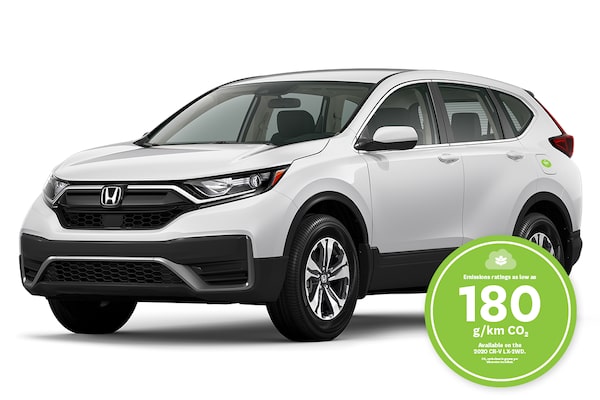
Honda Canada now provides customers with clear details of the carbon emissions produced by each of its vehicles, including the 2020 CR-V.supplied
These are confusing times. Consumers are bombarded with countless sources of information, and it’s difficult to sort out fact from fiction.
Honda Canada has responded with a clear and concise approach to communicating the environmental footprint of its vehicles. In an era of growing climate-change awareness, consumers and environmentalists want to know how the automotive industry is taking action, and confusion should not be an option when it comes time to make a purchase.
The new campaign, available to view at honda.ca, provides verified data on CO2 emissions for each model sold in Canada, and it gives consumers useful information on reducing their own carbon footprints. The campaign doesn’t just represent a return to the company’s roots, says Jean Marc Leclerc, senior vice-president of sales and marketing for Honda Canada – it’s a reaffirmation.
“A focus on fuel efficiency and using fewer resources has been part of our DNA for a long time,” he explains. “We have a history in this space, so we believe it’s our responsibility at Honda Canada to change the conversation, to get consumers thinking about greenhouse gas (GHG) emissions in a different way.”
An industry first, the campaign builds on the most recent federal government GHG report, entitled Greenhouse Gas Emissions Performance for the 2017 Model Year Light-Duty Vehicle Fleet, published by Environment & Climate Change Canada last year. The report verifies that the Honda Canada fleet had the best overall fuel economy in the industry, and lower-than-average carbon emissions among internal combustion engine (ICE) manufacturers.
Based on the data, the Honda Canada website lists how many grams of CO2 its vehicles emit per kilometre. It’s a recognition by the company that environmental performance is a competitive advantage.
“The campaign follows the model the food industry used when it introduced calorie counts,” Leclerc says. “The automotive industry is far behind the food industry right now, but we can bridge the gap – it’s all about giving consumers what they need to make informed decisions.”
Visitors to the Honda Canada website can also make quick comparisons among models. For example, a shopper interested in a Honda Pilot because it suits their lifestyle may decide that they can make a Honda Civic work instead. “The core of the idea is to focus – or refocus – on reducing greenhouse gas emissions,” Leclerc says.
“Whether you’re driving an SUV with an internal combustion engine or a compact car or a hybrid, there are vehicles in every category that perform better than others. At Honda, we have some of the best performing vehicles in the business and we’re just reintroducing this to the Canadian consumer from a different perspective.”
The Honda Canada campaign, Driven to Reduce Emissions Since 1948, says its global organization plans for electric to represent two-thirds of its vehicle sales by 2030, an ambitious target that incorporates a measured approach to technological innovation. It aims to reduce carbon emissions across its business and manufacturing operations.
This focus on the environment also extends to a number of social causes in Canada, as one of four key pillars of the Honda Canada Foundation. Through the Foundation, Honda partners with charities that bring environmental education to classrooms and after-school programs across Canada.
The Foundation’s long-term partnership with Earth Rangers, a kids’ conservation organization, educates young people across the country about animals and the environment through the School Assembly Program, igniting a spark of enthusiasm that motivates children to start taking action to help protect the environment.
Concern for the environment is not new to Honda. In 1972, the company introduced the CVCC engine, the first to meet U.S. Clean Air Act standards without the need for a catalytic converter. And last year, it announced a long-term agreement to purchase renewable wind and solar power to cover more than 60 per cent of the company’s electricity requirements in North America.
All of Honda Canada’s decisions fall under the global “Blue Skies for Our Children” umbrella: a wide-ranging environmental directive to do what the company can to give future generations the opportunity to experience the joy and freedom of mobility while living in a sustainable society.
Advertising feature produced by Globe Content Studio. The Globe’s editorial department was not involved.